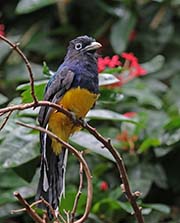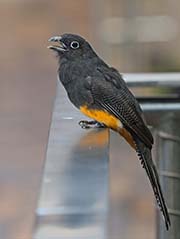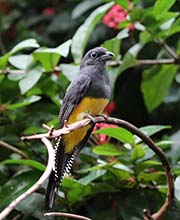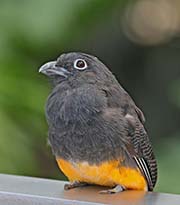White-tailed Trogon - Trogon chionurus
| Length | |
| Weight | |
| Clutch Size | |
| Chicks at birth | |
| IUCN Conservation Status | |
Continents: |
The White-tailed Trogon is also known as the Western White-tailed Trogon. The White-tailed Trogon is sexually dimorphic. Males are black with a metallic green and blue wash over their black feathers. Their belly is orange-yellow and the undersides of their tail is mostly white. Female do not have the metallic green and blue wash and are more gray than black. Their tail is barred black and white. Both sexes have a pale blue eye-ring, reddish brown eyes, and gray bill, legs and feet.
Diet: They mainly feed on small fruit and arthropods (insects and spiders).
Courtship: Purple-throated Fruitcrows breed cooperatively. Cooperative breeding is when individuals contribute care to offspring that are not their own at the expense of their own reproduction.
Nesting: Their nest is a untidy shallow platform or saucer shaped nest built of twigs. 1-2 eggs are laid. Young birds are vulnerable to predation because they spend most of their time on low branches on the ground.
Habitat and Range: Their primary habitat is subtropical/tropical moist lowlands up to 1,000m. They are found from Panama, through western Colombia, to western Ecuador.
Vocalization: They have a variety of loud and mellow calls. Their call has been described as a cooing sound.
Plumage/Molt They do not have an alternate plumage.
Migration: Non-migratory.
Tongue/feet: Gray legs and feet.
Bibliography:
- http://en.wikipedia.org The Free Encyclopedia, Accessed November, 2012
- http://neotropical.birds.cornell.edu/portal/home The Cornell Lab of Ornithoogy Neotropical Birds, Accessed November, 2012
- http://aqua.org/explor/animals/ National Aquarium, Accessed November, 2012




